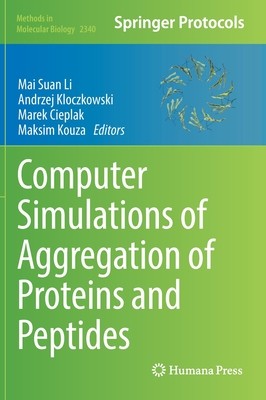
- We will send in 10–14 business days.
- Publisher: Humana
- ISBN-10: 1071615459
- ISBN-13: 9781071615454
- Format: 18.8 x 26.2 x 2.5 cm, hardcover
- Language: English
- SAVE -10% with code: EXTRA
Computer Simulations of Aggregation of Proteins and Peptides (e-book) (used book) | bookbook.eu
Reviews
Description
1. Bioinformatics Methods in Predicting Amyloid Propensity of Peptides and Proteins
Malgorzata Kotulska and Jakub W. Wojciechowski
2. Protocols for Rational Design of Protein Solubility and Aggregation Properties using Aggrescan3D Standalone
Aleksander Kuriata, Aleksandra E. Badaczewska-Dawid, Jordi Pujols, Salvador Ventura, and Sebastian Kmiecik
3. Using Surface Hydrophobicity Together with Empirical Potentials to Identify Protein-Protein Binding Sites. Application to the Interactions of E-cadherins
Robert L. Jernigan, Pranav Khade, Ambuj Kumar, and Andrzej Kloczkowski4. Computational Models for Study of Protein Aggregation
Nguyen Truong Co, Mai Suan Li, and Pawel Krupa
5. Probing Protein Aggregation Using the Coarse-Grained UNRES Force Field Ana V. Rojas, Gia G. Maisuradze, Harold A. Scheraga, and Adam Liwo
6. Contact-based Analysis of Aggregation of Intrinsically Disordered Proteins
Marek Cieplak, Lukasz Mioduszewski, and Mateusz Chwastyk
7. Molecular Insights into the Effect of Metals on Amyloid Aggregation
Yifat Miller
8. From Quantum Mechanics, Classical Mechanics and Bioinformatics to Artificial Intelligence Studies in Neurodegenerative Diseases
Orkid Coskuner-Weber, M. Gokhan Habiboglu, David Teplow, and Vladimir N. Uversky
9. Computer Simulations Aimed at Exploring Protein Aggregation and
Dissociation
10. All-atom Molecular Dynamics Simulation Methods for Aggregation of Protein and Peptides: Replica-exchange/permutation and Nonequilibrium Simulations
Satoru G. Itoh and Hisashi Okumura
11. Key Factors Controlling Fibril Formation of Proteins
Tran Thi Minh Thu, Andrzej Kloczkowski, Mai Suan Li, and Maksim Kouza
12. Determination of the Most Stable Packing Of Peptides From Ribosomal S1 Protein, Protein Bgl2p and Aβ peptide in β-layers during Molecular Dynamics Simulations
Glyakina A.V., Balabaev N.K., and Galzitskaya O.V
13. Molecular Dynamics Simulations Of Protein Aggregation: Protocols For Simulation Setup and Analysis with Markov State Models And Transition Networks
Suman Samantray, Wibke Schumann, Alexander-Maurice Illig, Arghadwip Paul, Bogdan Barz, and Birgit Strodel
14. Challenges in Experimental Methods
Marlena E. Gąsior-Glogowska, Natalia Szulc, and Monika Szefczyk
15. Aggregates Sealed By Ions
Giovanni La Penna and Silvia Morante
16. Modifying Amyloid Motif Aggregation through Local Structure
Sofia Bali and Lukasz A. Joachimiak
17. Assessing the Stability Of Biological Fibrils By Molecular-Scale Simulations
Rodrigo A. Moreira
18. Predictive Modeling of Neurotoxic α-Synuclein Polymorphs
Liang Xu, Shayon Bhattacharya, and Damien Thompson19. Characterization of Amyloidogenic Peptide Aggregability in Helical Subspace
Shayon Bhattacharya, Liang Xu, and Damien Thompson
20. Exploration of Protein Aggregations in Parkinson's Disease through Computational Approaches and Big Data Analytics
Saba Shahzadi, Muhammad Yasir, Bisma Jawad, Sumbal Baber, Mubashir Hassan
21. Computational Studies of Protein Aggregation In Preeclampsia
Maksim Kouza, Andrzej Kolinski, Irina Buhimschi, and Andrzej Kloczkowski
22. Final remarks
Mai Suan Li, Andrzej Kloczkowski, Marek Cieplak, and Maks
EXTRA 10 % discount with code: EXTRA
The promotion ends in 17d.14:16:16
The discount code is valid when purchasing from 10 €. Discounts do not stack.
- Publisher: Humana
- ISBN-10: 1071615459
- ISBN-13: 9781071615454
- Format: 18.8 x 26.2 x 2.5 cm, hardcover
- Language: English English
1. Bioinformatics Methods in Predicting Amyloid Propensity of Peptides and Proteins
Malgorzata Kotulska and Jakub W. Wojciechowski
2. Protocols for Rational Design of Protein Solubility and Aggregation Properties using Aggrescan3D Standalone
Aleksander Kuriata, Aleksandra E. Badaczewska-Dawid, Jordi Pujols, Salvador Ventura, and Sebastian Kmiecik
3. Using Surface Hydrophobicity Together with Empirical Potentials to Identify Protein-Protein Binding Sites. Application to the Interactions of E-cadherins
Robert L. Jernigan, Pranav Khade, Ambuj Kumar, and Andrzej Kloczkowski4. Computational Models for Study of Protein Aggregation
Nguyen Truong Co, Mai Suan Li, and Pawel Krupa
5. Probing Protein Aggregation Using the Coarse-Grained UNRES Force Field Ana V. Rojas, Gia G. Maisuradze, Harold A. Scheraga, and Adam Liwo
6. Contact-based Analysis of Aggregation of Intrinsically Disordered Proteins
Marek Cieplak, Lukasz Mioduszewski, and Mateusz Chwastyk
7. Molecular Insights into the Effect of Metals on Amyloid Aggregation
Yifat Miller
8. From Quantum Mechanics, Classical Mechanics and Bioinformatics to Artificial Intelligence Studies in Neurodegenerative Diseases
Orkid Coskuner-Weber, M. Gokhan Habiboglu, David Teplow, and Vladimir N. Uversky
9. Computer Simulations Aimed at Exploring Protein Aggregation and
Dissociation
10. All-atom Molecular Dynamics Simulation Methods for Aggregation of Protein and Peptides: Replica-exchange/permutation and Nonequilibrium Simulations
Satoru G. Itoh and Hisashi Okumura
11. Key Factors Controlling Fibril Formation of Proteins
Tran Thi Minh Thu, Andrzej Kloczkowski, Mai Suan Li, and Maksim Kouza
12. Determination of the Most Stable Packing Of Peptides From Ribosomal S1 Protein, Protein Bgl2p and Aβ peptide in β-layers during Molecular Dynamics Simulations
Glyakina A.V., Balabaev N.K., and Galzitskaya O.V
13. Molecular Dynamics Simulations Of Protein Aggregation: Protocols For Simulation Setup and Analysis with Markov State Models And Transition Networks
Suman Samantray, Wibke Schumann, Alexander-Maurice Illig, Arghadwip Paul, Bogdan Barz, and Birgit Strodel
14. Challenges in Experimental Methods
Marlena E. Gąsior-Glogowska, Natalia Szulc, and Monika Szefczyk
15. Aggregates Sealed By Ions
Giovanni La Penna and Silvia Morante
16. Modifying Amyloid Motif Aggregation through Local Structure
Sofia Bali and Lukasz A. Joachimiak
17. Assessing the Stability Of Biological Fibrils By Molecular-Scale Simulations
Rodrigo A. Moreira
18. Predictive Modeling of Neurotoxic α-Synuclein Polymorphs
Liang Xu, Shayon Bhattacharya, and Damien Thompson19. Characterization of Amyloidogenic Peptide Aggregability in Helical Subspace
Shayon Bhattacharya, Liang Xu, and Damien Thompson
20. Exploration of Protein Aggregations in Parkinson's Disease through Computational Approaches and Big Data Analytics
Saba Shahzadi, Muhammad Yasir, Bisma Jawad, Sumbal Baber, Mubashir Hassan
21. Computational Studies of Protein Aggregation In Preeclampsia
Maksim Kouza, Andrzej Kolinski, Irina Buhimschi, and Andrzej Kloczkowski
22. Final remarks
Mai Suan Li, Andrzej Kloczkowski, Marek Cieplak, and Maks


Reviews